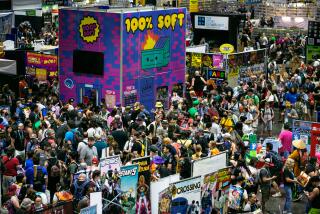A Summit for Powers of Invention : Convention: Inventors will descend on Pasadena in hopes of finding investors, marketing tips and public feedback.
- Share via
Lou Rosenlund of Los Angeles was lugging concrete blocks to build a pig pen on his Montana ranch and complaining about how heavy they were when he got the idea. Why not build a lightweight block that would be just as strong? Five years later, he has just that--a lightweight block that he can drive his Cadillac over--and he’s on his way to the Invention Convention in Pasadena this weekend to market it.
Though not an inventor himself, Stephen Paul Gnass created the Invention Convention four years ago. It’s a big marketplace where inventors can interest investors in their devices and, perhaps, get them into production.
All types of inventions will be exhibited, from toys to flying boats, Gnass said, adding, “We’re not fixed in an identity.”
“The convention focuses on inventors, and all the people you need in business show up in one place,” said Eric Stoft of Sylmar, inventor of Grocery Tote, a small plastic device that enables shoppers to easily carry more than one plastic grocery bag at a time. Stoft exhibited his invention last year and says the results were “fantastic . . . . I would never have imagined that one weekend in September could change my small business venture into a growing manufacturing company.”
Stoft plans to return to the Invention Convention this weekend to look for additional distributors for his product. “Last year I was brand new at this, real green,” he said. “And I still made so many fantastic contacts and expanded into Canada. This year, I’ll get more out of the convention because of what I know now. The convention helps you in getting the experience.”
Since its 1987 start, the Invention Convention has caught on not only with local inventors, but also with international ones. A delegation of 20 inventors and entrepreneurs from China will attend, as will representatives from the Philippines, Korea, Japan, Thailand, Australia, France, Switzerland and Sweden. Gnass’ company, International Convention Services in Hollywood, which produces the show, may hold another convention next year in a Pacific Rim country.
This showcase, at the Pasadena Convention Center Friday through Sept. 3 (open to the trade only on Friday), has grown from 150 exhibitors in 1987 to almost 400 this year. About 1,000 inventions will be on display.
(General admission tickets, which include five seminars, are $25 for three days, $20 for two, $15 for one. Seniors and children receive a 50% discount. For each general admission ticket sold, $1 will go to Easter Seals.)
On Sunday, Paul MacCready of AeroVironment in Monrovia, developer of the Gossamer Condor, the first successful human-powered plane, will be the keynote speaker. Awards will be given in different categories.
“It’s like a crash course in the invention process,” Gnass said of his convention. “The common denominator with inventors is that they have the ideas, but don’t know how to get the product to market. The show provides that knowledge for them and introduces them to people who buy, license and manufacture. It’s a real network, like a big dating game.”
The convention will feature many environmental and alternative energy-use products, including the Wave Pump, a device that uses waves to produce electricity; Mini-Flush, a water-conservation device for toilets; a dental unit that cleans and drills teeth and fits in a small briefcase; a fuel-efficient mini-generator; a heavy-duty plastic fork with a cutting edge; a theft-proof grocery cart, and a lightweight building block.
There will also be such lighthearted offerings as Flip N Grip, a football and gloves with Velcro-like strips that make catching easy; the Club Trap, a security system for golf clubs and bag; the See Sled, which powers scuba divers to their destination and provides a surface float; a pogo stick exerciser; a Bubbleator, which attaches to a bicycle seat and emits soap bubbles, and Khwikball, a new game played with a net, rackets and a ball.
Bob Koon, a self-described “football nut,” invented Flip N Grip after watching “weekend footballers trying to be professional. I decided to make everyone a professional. Now, anyone can make those marvelous fingertip catches.
“And it’s great for kids. Small kids can’t catch a regular ball.”
“On the whole, most people are coming to sell their invention or to license it and go on to the next invention,” Gnass said. “Very few Edisons today can run a business and market a product. They create the idea and need someone else to do the rest. The show itself will tell you if a product will sell. The reason we let the public in is to do market research.”
Gnass, a former small business consultant, and his associates encourage inventors with product samples to offer them for sale in order to get reaction. “You can find out if it’s priced right, if it’s too big or too small, if it’s packaged right,” he said.
Gnass cautioned inventors to let go of the invention if they’re offered a good deal. “It’s like with children,” he said. “When they grow up, you’ve got to cut the cord and let go. Inventors often have a hard time letting go. A couple of years ago, a guy was offered $1 million for a prosthetic arm he’d developed. He turned it down, and he later went broke.”
Getting an invention to the convention is not cheap. In addition to money spent on plans, prototypes and patents, which can run from a few thousand dollars to $50,000 or more, show booths cost from $550 to $1,700.
That fee covers more than 100 seminars, panel discussions and several consultations with Invention Convention staff members, who advise participants on contacts, product displays and marketing research. Each participant also receives a follow-up consultation, including instruction on “speed-marketing” techniques developed by Gnass.
“If you follow what we’re doing, using the tools we give you, the odds of your success will be increased,” Gnass said. “We’re forcing inventors to participate. Success doesn’t come to those who sit on the fence. Speed is the thing--whoever gets to the market fastest wins.”
Gnass said that the Invention Convention so far has failed to turn a profit for his company, but he hopes that the number of entries this year may put him in the black. “The first year, we lost a lot of money; the second, half of that, and the third, we broke even,” he added.
The United States has a real need to encourage inventors, Gnass says, citing the fact that more U.S. patents are given to foreigners or foreign countries each year than to Americans.
Norman Parrish, president of the National Congress of Inventor Organizations, a nonprofit umbrella group for inventors, agreed. “Inventors need to be stimulated and encouraged,” he said. “Especially the children.
“Japan teaches its 5- and 6-year-olds to think independently, come up with four or five solutions to a problem,” Parrish added. “By the time that child is 20 years old, he or she is thinking innovatively. America has been teaching children to think as they are told, not innovatively. That has to change. Kids come up with some tremendously good ideas.”
At his first Invention Convention, Brian Walker, who recently moved to Los Angeles from Oregon to promote his inventions, plans to exhibit six different ones, including the See Sled and the Porta Litter, a canvas device that can be turned into a litter and a field cot in less than a minute. It can be topped with a tent, transforming the unit into an emergency shelter.
“I don’t have a lot of money,” Walker said, adding that inventors are usually broke. “I’ve worked on the litter alone for about eight years, spent $10,000 and 7,000 or 8,000 hours of time. I haven’t made a penny off any of my inventions. But I’m counting on this show, that something is going to happen from it. The opportunity is there.”
More to Read
Inside the business of entertainment
The Wide Shot brings you news, analysis and insights on everything from streaming wars to production — and what it all means for the future.
You may occasionally receive promotional content from the Los Angeles Times.










